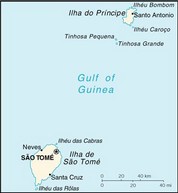Main menu:
São tomé e Principe
Introduction |
||
Flag: |
|
|
Card: |
|
|
Background: |
Discovered and claimed by Portugal in the late 15th century, the islands' sugar-based economy gave way to coffee and cocoa in the 19th century - all grown with plantation slave labor, a form of which lingered into the 20th century. Although independence was achieved in 1975, democratic reforms were not instituted until the late 1980s. The first free elections were held in 1991. |
|
Geography |
||
Location: |
Western Africa, islands in the Gulf of Guinea, straddling the Equator, west of Gabon |
|
Coordinates: |
1° 00' N, 7° 00' E |
|
Map references: |
Africa |
|
Area: |
total: 1,001 sq km |
|
Land boundaries: |
0 km |
|
Coastline: |
209 km |
|
Climate: |
tropical; hot, humid; one rainy season (October to May) |
|
Terrain: |
volcanic, mountainous |
|
Elevation extremes: |
lowest point: Atlantic Ocean 0 m |
|
Natural resources: |
fish, hydropower |
|
Land use: |
arable land: 2% |
|
Irrigated land: |
100 sq km (1993 est.) |
|
People |
||
Population: |
165,034 (July 2001 est.) |
|
Nationality: |
noun: Sao Tomean(s) |
|
Ethnic groups: |
mestico, angolares (descendants of Angolan slaves), forros (descendants of freed slaves), servicais (contract laborers from Angola, Mozambique, and Cape Verde), tongas (children of servicais born on the islands), Europeans (primarily Portuguese) |
|
Religions: |
Christian 80% (Roman Catholic, Evangelical Protestant, Seventh-Day Adventist) |
|
Languages: |
Portuguese (official) |
|
Government |
||
Country name: |
conventional long form: Democratic Republic of Sao Tome and Principe |
|
Government type: |
republic |
|
Capital: |
SaoTome |
|
Independence: |
12 July 1975 (from Portugal) |
|
National holiday: |
Independence Day, 12 July (1975) |
|
Flag description: |
three horizontal bands of green (top), yellow (double width), and green with two black five-pointed stars placed side by side in the center of the yellow band and a red isosceles triangle based on the hoist side; uses the popular pan-African colors of Ethiopia |
|
Economy |
||
Economy - overview: |
This small poor island economy has become increasingly dependent on cocoa since independence 25 years ago. However, cocoa production has substantially declined because of drought and mismanagement. The resulting shortage of cocoa for export has created a persistent balance-of-payments problem. Sao Tome has to import all fuels, most manufactured goods, consumer goods, and a significant amount of food. Over the years, it has been unable to service its external debt and has had to depend on concessional aid and debt rescheduling. Sao Tome benefited from $200 million in debt relief in December 2000 under the Highly Indebted Poor Countries (HIPC) program. Considerable potential exists for development of a tourist industry, and the government has taken steps to expand facilities in recent years. The government also has attempted to reduce price controls and subsidies, but economic growth has remained sluggish. Sao Tome is also optimistic that significant petroleum discoveries are forthcoming in its territorial waters in the oil-rich waters of the Gulf of Guinea. Corruption scandals continue to weaken the economy. At the same time, progress in the economic reform program has attracted international financial institutions' support, and GDP growth will likely rise to at least 4% in 2001-02. |
|
Industries: |
light construction, textiles, soap, beer; fish processing; timber |
|
Currency: |
SaoTome Dobra (STD) |
|
Currency code: |
STD |
|
Transportation |
||
Railways: |
0 km |
|
Highways: |
total: 320 km |
|
Waterways: |
none |
|
Ports and harbors: |
Santo Antonio, SaoTome |
|
Coffee |
||
Coffee drinkers, if there are one of the elected, who were able to taste coffee from Sao Tome and Principe ever - are enthusiastic about the excellent quality of the coffee taste |
||
Coffeetyp: |
Arabica |
|
Main customers: |
Scandinavia, the Benelux countries |
|
Classifikation: |
sizes and flavors |
|
Harvest volume: |
ca. 1.000 bags (each 60 kg net.) |
|
Fermentation: |
Yes |
|
Sorting: |
by hand |
|












